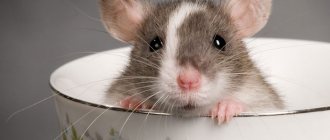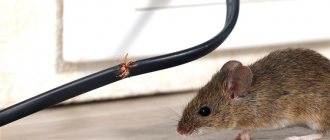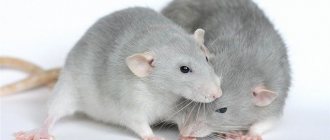What does a domestic rat look like?
The appearance of the domestic rat has not undergone major changes compared to its wild relatives. Most animals have an elongated, stocky body and a long hairless tail covered with sparse bristles. The size of the animal can be from 8 to 30 cm, and its weight can be up to 400-500 g. The elongated head is crowned with round ears, the eyes are small and bulging. The jaw of rats consists of 4 front incisors and molars. Different breeds of decorative rats differ in the structure of their fur:
- smooth;
- thin and shiny;
- curly;
- downy
There are animals without hair, for example, sphinxes and rodents with mixed coats. Colors can be plain or mixed. From gray and brown to orange and blue.
The bald sphinx is a type of rat.
In Dumbo rats, the ears “sit” not on the top of the head, but lower, like those of elephants. As a result of the mutation, rats were born with no tail at all.
Caring for newborn rat pups
After about 3 weeks, the Dumbo rat pups are born. Childbirth in domestic rats is easy. The female does not need postpartum care if everything went well. She spends most of her time in the nest, where she feeds and warms the babies.
Rats are born completely helpless. There is no hair on the body, eyes and ears are closed. Mom takes good care of them. Although she has 12 teats, she can feed up to 22 cubs if necessary.
Recommendations for caring for Dumbo rat pups are simple. The main thing is not to handle them until they are 2 weeks old. During this time, they will be transformed - their bodies will be covered with delicate fur, their eyes will open, and hearing will appear. Rat pups begin to be switched to adult food at three weeks of age. When the babies turn 1 month old, you can give them to new owners.
Is the smell of a dead rat dangerous?
Not everyone knows that the smell of a dead mouse or rat not only spoils the air, but can also cause serious harm to human health. The fact is that the decomposing corpses of rodents release toxic substances into the air, which quickly spread throughout the entire area of the room and the area adjacent to the house. Therefore, in order to avoid negative health consequences, it is necessary to get rid of the smell of a dead rat under the floor as soon as possible.
How to find and dispose of a dead rat
Before eliminating the smell emanating from a dead mouse, you will first need to find its body. To determine the location of a dead animal, you must perform the following steps:
- First, you need to understand which room smells the worst - that’s where you should look for the place where the rat or mouse died.
- Remove carpets and rugs, as well as remove flooring in the room where the rodent died.
- Take a good sniff to understand in which part of the room the unpleasant odor is concentrated - this is where you will need to tear the board off the floor. If you cannot identify a specific area in which the mouse died, it is best to remove the board located in the center.
- Using a thin long stick, try to feel the rodent under the floor and carefully remove it.
All of the above actions should be performed exclusively in a respirator or at least a medical mask. In this case, you will need to protect your hands with rubber gloves.
What to do with a dead rat
After finding a dead mouse under the floor, you need to place it in a plastic bag and take it out of the house. It is then possible to dispose of the rodent in two ways:
- Bury away from residential areas. In this case, the hole must be deep enough.
- Pack the rodent tightly in several bags and place it in the trash.
Duration of decomposition
Everyone wonders how long it takes for a rat to decompose. Because no one can tolerate the terrifying smell for long. The situation is complicated by the fact that the corpse of a rat takes from 6 to 10 weeks to decompose. The process depends on temperature conditions. The hotter the room, the faster this will all end.
Mummifying substances are added to modern rat poison for such cases. The body does not rot and dries slowly. The situation may develop differently. If a rat eats an insufficient dose of rat poison to trigger the mummification process. In this case, the remains rot for up to 2 months; the decomposition process is long.
What to do if a rat died under the floor is an individual decision. You can try to solve the problem yourself or entrust it all to specialists.
Do pet rats bite?
They bite, but extremely rarely. There are a number of cases when a rat can bite:
- fright;
- pain;
- error. The animal tastes everything, so a finger inserted through the bars can be perceived as food;
- transitional age in males. From 5 months, males can bite in an attempt to dominate;
- female pregnancy. A pregnant and lactating female is able to claw, protecting the offspring.
Rats nip rather than bite
In almost all cases, the owner himself is to blame. Mild biting by animals is a form of communication. The pet is trying to attract the attention of its adored owner.
Important! Physical punishment for a bite is the biggest mistake: a rat may lose trust in a person.
In the case of dominance, you can either turn the “impudent” guy onto his back and hold him in that position or sprinkle him with water. Usually it is enough to drive the pet away from you or stop playing with it.
What should a rat cage look like?
The optimal home for a rat would be a cage made of metal rods with a tray. Rats can climb on the grates, they are well ventilated and allow you to observe what is happening around. The distance between the rods should be about 1.5-1.7 cm (or less). If the bars are too thin (2 cm or more), the baby rats will try to crawl between the bars. At best, the pet will simply run away, and at worst, it will get stuck and suffer.
Excuse me, do you have anything tasty for the poor little rat?
In addition to size, the configuration of the cell is important. A flat (low) cage is not an option. No matter how big it is, the animals will be bored in it. Guinea pigs or hamsters live in fields, and the rat world is more complex and varied. The cage should have several levels.
A real palace for rats
- Glass containers (jar, aquarium, terrarium)
- Plastic container/dune
- Small cage for mice or hamsters
It is better if the metal rods are painted. Then they will not oxidize from the caustic urine of animals, and there will be no stains on them.
“I’m sitting behind bars in a damp dungeon.” Painted rods are the best option for rats.
There are two types of cage trays: with and without a false bottom. The false bottom is designed like this: the animals run along the grate, the tray is located below. The mesh should be fine enough so that the rats do not fall through with their paws. But not too much - so that feces fall through.
- Rats are always clean;
- You can use any type of filler;
- The filler is not scattered around the cage;
- Convenient to clean.
- An unsuitable grid can cause damage and inflammation of the skin on the paws - pododermatitis;
- Potential possibility of injury (dislocations, fractures);
- Rats are deprived of the opportunity to rummage through the litter;
- If a rat drops a treat from its paws, it is lost forever.
Overall, using a plastic false bottom seems like a great idea to me. It can be partially covered to make the rats more comfortable, additionally put paper towels in the cage for the house and hang hammocks for sleeping.
The shelves are lined with soft fleece fabric: it is soft, dries quickly, and does not tangle your paws
Cute, smart, ratty animal, but not for everyone. Update from 01/17/17!
One fine sunny day I was wandering through pet stores and in one of them I caught my eye on a cute fluffy rat, peacefully dozing among his fellows.
I’ve had the dream of owning a rat for a long time, I’ve looked at many, but I haven’t caught my eye on anyone. There was a feeling that something was wrong. And then I felt it right in my heart, mine. And so the handsome and clever Grizzly appeared in our family. Already at the time of purchase it became clear that our character is not the simplest. The rat developed a vigorous activity and was very indignant at the fact that he was pulled out of a cozy aquarium and transplanted into some strange carrier with sawdust. Then he was indignant all the way about being seasick. Well, in the end he was indignant that the cat was encroaching on his cage.
The cat, who had lived alone in the house for 4 years before him, took the guest surprisingly calmly, although she did not have much love for him at the very beginning. She didn’t come close to him, she looked at him from afar. It happened that I tried to climb into the Grizzly’s cage when he was running around the room and drink from his drinking bowl.
So the rats lived with us for about 4 years. Let me note right away that I bought it no longer as a small rat, there was already a quite large rat, which had practically not grown in its entire life in our house. This animal is extremely smart. Once he tried to chew the wire. But after they scolded him, he abandoned this activity and never returned to it. He ate almost everything. Starting from special food, ending with the food that we prepared for him at home. He really loved treats for rodents. Especially the stumps. The character is very affectionate and calm. He never bit anyone out of nowhere or attacked anyone. If you pet him, he immediately licks your hands in response.
Now let me move on to the sad side of these creatures. Firstly, they are very fragile. In all senses. Any draft, too hard a floor and unsuitable sawdust can cause serious problems for them. A draft can cause otitis media. Which, if not cured, ends extremely badly. Hard floors cause corns to appear, which prevent the rat from walking and running normally. And if they are not treated, you will have to resort to surgery, because they will not disappear or resolve on their own. And if you use softwood sawdust, be prepared for the fact that your pet may develop allergies. He will constantly itch, sneeze and have a runny nose. And they can also break something from any unfortunate fall, which is also very difficult and takes a long time to treat. Therefore, I say right away, this is not a toy for small children at all.
Secondly, there is a very common myth that you can feed rats even waste from a garbage dump, nothing will happen to them. This is wrong. If you skimp on food, you will then have to pay a large sum to the veterinarian for the treatment of your pet. Their gastrointestinal tract is also very sensitive.
And finally, the last minus. If you live in a small town. Be prepared for the fact that your pet is unlikely to receive normal medical care. There are very few rat specialists in such towns. And often they are not there at all. This is exactly the situation I faced when I needed the advice of a so-called ratologist.
In general, I tried to describe everything in great detail. If you have any questions, ask, I will answer with pleasure.
I completely forgot to share my joy. The Grizzlies have been replaced by a new generation of funny, jumping rats. Two sweet girls were taken home by me in the fall. Past mistakes have been taken into account. The rats were taken in pairs to avoid boredom and moved to a nightstand in a room where the window did not open. So as not to catch a cold. Photos are attached!
Source
Causes of unpleasant odor
Among the reasons why an unpleasant odor appears, we can list those that relate to the pet and those that relate to the equipment.
If they talk about accessories, then note the following:
- some materials absorb and retain odors better, so even a washed cage can have an individual specific aroma;
- fillers can have both an unpleasant odor and enhance the acquired odor;
- In summer, due to rising air temperatures, microbes develop more intensively, which becomes the reason for intense aromatization.
Interestingly, fresh daytime urine does not stink. But overnight it decomposes and begins to release ammonia - the main source of stench, so thoroughly clean the cage once a week. Be sure to wash all surfaces with warm water and soap. Change the materials from which the rat makes its nest once every 2 days until the problem is eliminated. Wipe down the areas around the cage as well. When the male marks the territory, the spray spreads beyond the zone of tactile contact.
Important! If the odor is strong, clean the cage daily. Next, take paper towels, soak them in white vinegar, and press them firmly into the cracks to absorb odors and kill bacteria.
To prevent odors from escaping from the cage, use only bedding materials that are recommended for rats. They absorb secretions and minimize their odor. Also reduce the amount of cardboard, toilet paper and paper towels you give your pet. They entertain him a lot, but the cellulose absorbs urine and then “smells” very strongly.
And, oddly enough, a plastic cage also retains odors very well, so it needs to be washed more intensively than a metal or wooden one.
If we talk about pets, then:
- some rats are more indifferent to their appearance and this can cause them to acquire a specific stench;
- males smell more intensely than females;
- certain breeds also have a stronger individual aroma;
- The smell of an older animal is more intense because it is not able to groom itself well.
Important! Don't play with your pet rat if you're angry or just not in the mood. Animals sense the state of their owners and will react to you in the same way.
And, of course, a sick animal can “smell” unpleasantly. For example, an excess of protein or sugar in the diet gives a specific aroma not only to the excrement, but also to the pet, so give the rat only the food that is included in its natural diet.
If the animal is sick, then, in addition to the smell, there are other signs. Among them are depression, apathy, cloudy or watery eyes, diarrhea, and vomiting. If you notice signs of ill health, take the animal to a veterinary clinic for examination, diagnosis and treatment.
Degu
Degus are rare domestic rodents, very active, cute, easily tamed animals. This rodent, like a chinchilla, needs a spacious cage with a house, a drinking bowl, a wheel and other toys for active games. A degu should always have specialized food in its feeder consisting of herbs, cereals and vegetables, as well as hay and branches for grinding down teeth. But sweet fruits and dried fruits are contraindicated for these rodents due to their predisposition to diabetes.
Degus are very sociable and get used to the hands of their owner and can recognize him by smell. This pet is a social animal, so it requires constant communication either with other degus or with its owner. Therefore, if you do not have enough time for your pet, buy him a pair.
How to walk a rat
It is better to refuse to walk a rat on the street: it is too dangerous: the animal can “pick up” an infection on the ground or in the grass. Any noise can cause panic, and the animal will run away. There is a category of pets that feel comfortable in their bosom. You can go out with such rodents in warm weather without putting them on the ground. However, it is better to carry your pets in a carrier.
A rat can only walk on your shoulder
For home leisure, you need to fence off the walk in a room where there are no wires or dangerous objects. You can release the animals on the sofa or table, but make sure that they do not fall.
Potassium permangantsovka
Potassium permanganate is used almost everywhere: small children are bathed with it, they drink it for intestinal disorders, it is used for disinfection, and much more. In addition, potassium permanganate copes with the destruction of stench much better than some odor neutralizers. Therefore, if a rat died under the floor or behind a wall, and the corpse began to emit a stench, potassium permanganate is perfect.
To remove the smell, it will be enough to simply wash the floors and baseboards in those places where rats most often ran, and spray it into those places (cracks) where the corpse of a rodent may be located. In addition, potassium permanganate will also destroy most of the harmful bacteria that parasites might leave behind, so the risk of becoming infected with something in the future is reduced to zero.
Potassium permanganate (potassium permanganate)
Features of processing various surfaces
The biggest problem arises when treating porous surfaces, as they tend to absorb odors. This feature is taken into account when disinfecting various materials.
Before processing, the chipboard must be freed from dust and dirt and degreased, and then a disinfectant must be applied on both sides. The final stage is to protect the surface with sealant or polish.
Drywall
If the drywall is soaked through, it is impossible to remove the smell from it. It will be easier to throw away the damaged sheet and replace it with a new one.
Natural wood
The wooden surface is cleaned in several stages:
- First of all, use any absorbent to remove residual liquid; for this purpose, cover the surface with an even, dense layer for some time.
- After removing the absorbent, the affected area is disinfected using folk remedies such as vinegar or potassium permanganate, or professional sprays.
- Finally, the wood is treated with sealant or polish.
Is it possible to transport rats on an airplane?
Theoretically it is possible, but it is a troublesome task:
Find out whether it is possible to transport a rat according to the rules of this airport. Find out whether your carrier transports rats. Obtain a veterinary certificate for the rodent 3 days in advance. Before check-in, go through veterinary control at the airport.
Do not forget about the laws of another country, whether the animal will be allowed there. It can only be carried in the cabin; it will not hold up in the luggage compartment. Don't put your rat through the scanner, it will hurt it. Don't open your rat's carrier on an airplane. It can only be fed through the grate.
Rats are reluctantly allowed on planes
Problems are easier to solve if you can reach an agreement with the aircraft crew.
Description and reasons for appearance
Human homes are subject to rodent invasion both in the cold season and in the heat. The main task of the colony is to find food and procreate. If one female gets into the house, then in a month there will already be twenty young individuals in the room, ready to breed. They are undemanding to the quality of food and eat everything that comes into their field of vision.
To know what repels rats, it is important to understand why they appear in this particular house. There are reasons that contribute to this “neighborhood”:
- Garbage bins. Animals go where it is easiest to get food. From compost pits, garbage dumps and tanks, they move to humans.
- Unharvested harvest. Fallen fruits in the garden and leftover vegetables on the plot will make an ideal dining room.
Rats have an excellent sense of smell, which is why they sense the presence of food in the house. - Sheds with livestock and storage facilities for raw materials. The buildings are warm and have food, so uninvited guests will feel comfortable.
Animals also penetrate into multi-storey buildings, getting from basements to apartments through ventilation and sewerage. With powerful teeth they destroy any obstacle except glass and metal. A small hole in the wall quickly turns into a huge door for landing troops to penetrate.
Rodents are carriers of dangerous diseases such as:
- typhus;
- salmonellosis;
- plague;
- tularemia.
In the first days, it is difficult to detect the presence of “neighbors,” but as the colony grows, squeaking, quiet grinding and stomping can be heard. An unpleasant odor and black shiny excrement appear in the room. If you look closely at the walls of the pantry, kitchen and bathroom, you can easily notice holes. Sometimes lumps of paper and pieces of rags are found around the house, and bags of cereals are always chewed through.
In this video you will learn how to drive rats out of your home:
Prevention
To prevent the appearance of mice, it is necessary to perform a number of preventive measures:
- First of all, you need to regularly carry out wet cleaning using disinfectants.
- Food products should be stored in tightly closed containers.
- Care must be taken to ensure that there are no crumbs or pieces of food left on the table or floor.
- It is useful in a village household to get a cat or borrow one from neighbors for a while, so that the animal leaves an unpleasant odor for rodents.
- Dried herbs are placed in the corners, the aroma of which mice do not like. Such plants include tansy, mint, wormwood, black root and chamomile.
- It is necessary to hermetically seal all cracks and openings through which rodents can enter the house.
- The use of ventilation grilles will prevent mice from climbing into the room through the ventilation shaft.
Mice are not the most pleasant neighbors, both in a private house and in an apartment. But it’s even more unpleasant to discover the corpse of a rodent in the neighborhood, emitting a pungent odor. To solve the problem, there are many methods, both folk and professional, that will help you quickly and easily get rid of unattractive aromas.










